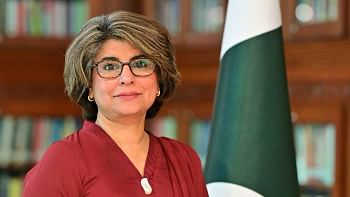Sculptures themed on the Liberation War
Sculpture is a three-dimensional art form and draws quick attention. It reflects culture, history and time. The main purpose of erecting a sculpture is to demonstrate one's artistic faculties through highlighting a certain theme.
Sculpture is considered one of the longest lasting genres of art. However, the trend of modern sculpture started here in the East Pakistan era, back in the 1950s. Novera Ahmed first achieved prominence in this field and she has popularised the medium in our country. In the 1950s and mid -1950s, Novera Ahmed had several sculpture exhibitions. Sculptures had, by this time, started to catch on in the local art scene. Despite many objections on erecting sculptures at public places, it was increasingly gaining popularity.
The Sculpture Department at the Institute of Fine Arts (now Faculty of Fine Arts, Dhaka University) was founded in 1965. Abdur Razzaque was the founder teacher of the department. Later on Anwar Jahan, Hamiduzzaman Khan and Shamim Shikdar joined the department as teachers. After the Liberation War, sculptures in Bangladesh mainly focused on the theme of the independence movement. Many significant sculptures were built in the mid '70s and early '80s. Here are some of the most remarkable sculptures on the theme of the Liberation War at a glance:
 Jagroto Chowrongi
Jagroto Chowrongi
Abdur Razzaque is regarded as one of the greatest sculptors of the country. He was the first artist to take up sculpture in independent Bangladesh. His 'Jagroto Chowrongi' is considered one of the best sculptures in Bangladesh, considering both form and theme, by art critics. Located in Joydebpur, and built in 1973, it is the first post-Liberation War sculpture. It depicts a Freedom Fighter with a grenade in his right and a rifle in his left hand. The sculpture is an 18 feet high concrete piece on a 24 feet pedestal.
After finishing 'Jagroto Chowrongi', Razzaque was encouraged to erect sculptures in different areas of the country. He liked to work with figures. He has made many semi-abstract and pure abstract pieces. These vary in media, materials and size. As medium he has used cement, stone, steel, iron, bronze and wood. In metals he has used both welding technique and casting.
 Aparajeyo Bangla
Aparajeyo Bangla
Syed Abdullah Khalid is a multi- talented artist. Khalid has not only excelled in sculpture but also made an impression with his paintings.
Khalid's “Aparajeyo Bangla” on Dhaka University campus has become an icon. The sculpture is a reflection of the Bengali vigilance and indomitable yearning for freedom. The project was launched in 1973 when this artist was a young teacher at the Department of Fine Arts, Chittagong University. Throughout the making of the sculpture, Khalid had to face opposition from religious fanatics.
Hasina Ahmed, Syed Hamid Moksood and Badrul Alam Benu, who are very close to Khalid, modelled for “Aparajeyo Bangla”. The artist closely observed the models' personalities and his close association with them enabled him to do justice with his portrayal. On August 15, 1975, the work suddenly came to a halt because of the heinous murder of Bangabandhu Sheikh Mujibur Rahman. Political instability and the arrest of the then Vice-chancellor of Dhaka University, Abdul Matin Chowdhury, also disrupted the work.
The project remained incomplete till the end of 1978. Some fundamentalist groups tried to demolish the sculpture in 1977. However, the brave students of Dhaka University fiercely guarded the work. After a long hiatus, the work began once more in the beginning of 1979 -- with a new vision. At last the project was finished on December 16, 1979. The sculpture was inaugurated by wounded freedom fighters.
 Shongshoptok
Shongshoptok
Hamiduzzaman Khan started his career not as a sculptor but a painter. On careful examination of his works, one will see that Khan endeavours to mix architectural or geometrical shapes with local materials found in his surroundings. His prime concerns are form and theme. In his form-oriented works, one finds a Western influence.
After 1971, the sculptor tried to understand the significance of sculptures and took interest in this art form. During that time, he concentrated on the Liberation War as a theme, and the subject was a great source of inspiration for Bangladeshi artists.One of his most moving creations is “Shongshoptok”. It stands 28 feet high, including the base. It is constructed of steel armature and brass steel. The work has been placed in front of the Central Library, Jahangirnagar University. It depicts a Freedom Fighter with a hand missing, yet ready to fight against the Pakistani forces. The fighter carries a rifle in his hand. It is a sign of the Freedom Fighters' valour and their dedication to the country.
 Shoparjito Shadhinota
Shoparjito Shadhinota
“Shoparjito Shadhinota” by renowned sculptor Shamim Sikder in memory of the Liberation War is located at TSC in Dhaka University. This was built in the early 1990 which expresses the delineation of varied sections of peoples' participation during the Liberation War. It represents the masses' movement in the war. This is a rather complex structure demonstrating many facets of 1971 -- violence upon people, Pakistani soldiers' brutality, the mass killing of intellectuals, unruly movements, farmers, valiant warriors, the moment of victory and others. The base itself is significant, as it holds a fresco all round portraying many happenings of the war.

 For all latest news, follow The Daily Star's Google News channel.
For all latest news, follow The Daily Star's Google News channel. 



Comments